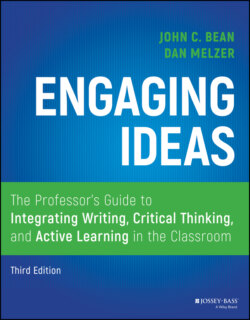Читать книгу Engaging Ideas - John C. Bean - Страница 60
Present Knowledge as Dialogic Rather Than Informational
ОглавлениеIn addition to creating cognitive dissonance for our students, we need to show them that our course readings, textbooks, and lectures are not simply “information‐to‐be‐remembered,” as if nothing were at stake, but contingent perspectives embedded in a field of inquiry, analysis, and argument. Suppose a history textbook enumerates the “five causes of the Civil War.” Novice students are apt to regard these five causes as facts or “right answers” to be memorized for a test. To grow as critical thinkers, they need to see these causes as interpretations by historians—as meaning‐making analyses open to revision and debate. In many academic disciplines—particularly the humanities and social sciences—teachers can easily situate course readings within a dialogic view of knowledge by showing students, for example, how existentialists are in conversation with Plato, how psychologists engage the nature/nurture debate, or how in literature and art postmodernists dismantle the meanings found by earlier critics. In other disciplines—particularly in STEM fields—introductory courses must transmit a disciplinary knowledge base of information that students must indeed commit to memory. But much of what is now “known” in the sciences—and passed on to students as current knowledge—was once unknown and subject to theory, hypothesis, and empirical research. If STEM teachers can promote awareness of the historical development of knowledge—the original questions that gave rise to the currently accepted facts—they will be foregrounding what we mean by a dialogic or questioning epistemology.
To illustrate the difference between information‐to‐be memorized and information situated within a dialogic structure, consider the approach of a much loved and now deceased historian at John's institution. In advance of a unit of lectures, this master teacher gave his students a series of controversial theses that brought the course's subject matter into problematic focus. The students knew in advance that they would need to use what they learned from lectures and readings to address each thesis in a short writing assignment. Typical theses used by John's colleague included the following:
The essential theme of the French Revolution was human freedom; Napoleon Bonaparte killed the French Revolution by reversing its thrust toward freedom.
The Industrial Revolution created unprecedented wealth at the expense of brutalizing European labor and colonial producers.
The ultimate victors in the English Revolution of 1688, the American Revolution, and the French Revolution were the economically conservative property‐owning classes.
In all cases, the writing assignment is the same: “present an argument that supports, rejects, or modifies the given thesis, and support your response with factual evidence.” This teacher's goal was to help students see the difference between history as one damn thing after another and history as a constructed argument based on data and interpretation.
